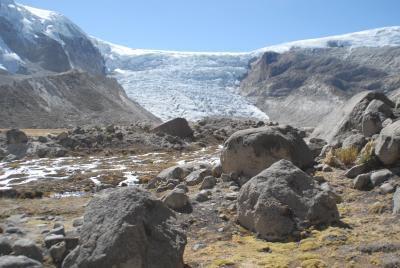Temperature has been driving the fluctuating size of Peru's Quelccaya Ice Cap, not snowfall, according to a new analysis. The Quelccaya Ice Cap is the largest ice mass in the tropics and sits 18,000 feet above sea level in the Peruvian Andes. The dramatic shrinkage of the tropical glacier in recent decades has made it a poster child for global climate change.
The findings support suspicions that tropical glaciers are shrinking because of a warming climate, and could help scientists to better understand the natural variability of past and modern climate and to refine models that predict tropical glaciers' response to future climate change.
Dartmouth glacier expert Meredith Kelly and colleagues used field mapping combined with the beryllium-10 surface exposure dating method and ice cores obtained by Ohio State University climatologist Lonnie Thompson to examine how the Quelccaya Ice Cap has expanded and retreated over the past millennium, the first time that a record of past glacial extents has been compared directly with an annually dated ice core record from the same ice mass.

A team studying Qori Kalis, the largest glacier emerging from Peru's Quelccaya Ice Cap, found that temperature, not snowfall, has been driving the fluctuating size of Quelccaya, the largest ice mass in the tropics. Credit: Dartmouth College
During the last millennium, a significant cooling event known as the Little Ice Age occurred, though it is unknown what caused the cooling or its geographic extent. The team determined beryllium-10 ages of moraines – or glacier sediments -- that mark the past positions of Qori Kalis, an outlet glacier that has been monitored by Thompson since he first visited Quelccaya in the early 1960s.
The results show that Qori Kalis advanced to its late Holocene maximum position prior to 520 years ago and subsequently retreated with only minor re-advances since that time. The comparison of the moraine record with the ice core record suggests that temperature was the driving force of glacial expansion and retreat, says Justin Stroup, lead author and a PhD candidate in Dartmouth's Department of Earth Sciences.
"This is an important result since there has been debate about the causes of recent tropical glacial recession – for example, whether it is due to temperature, precipitation, humidity, solar irradiance or other factors," says Kelly, a co-author of the study. "This result agrees with Professor Thompson's earlier suggestions that these tropical glaciers are shrinking very rapidly today because of a warming climate."
Furthermore, the ebbs and flows of other glaciers in tropical South America are similar to the Qori Kalis extents, indicating a regionally consistent pattern of past climate conditions. On a global scale, the results suggest that glaciers were larger than present and depositing moraines in both northern and southern hemispheres at about the same time, indicating that the climate mechanisms which caused the late Holocene cooling likely influenced a globally synchronous pattern of cooling.






Comments